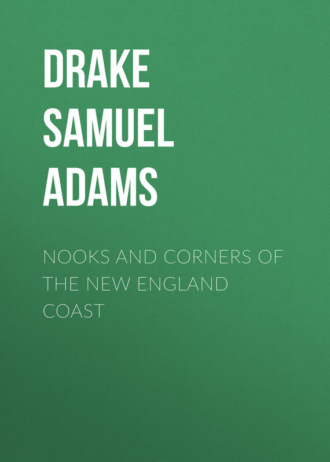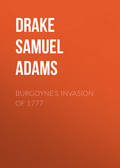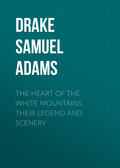
Drake Samuel Adams
Nooks and Corners of the New England Coast
I could see that even some of the best-informed Newporters with whom I talked were reluctant to let go the traditional antiquity of their Old Stone Mill. It is more interesting when tinged with the romance of Norse vikings than as the prosaic handiwork of English colonists, who had corn to grind, though American antiquaries have ceased to attribute to it any other origin. I confess to a feeling of remorse in aiding to destroy the illusion which has so long made the Old Mill a tower of strength to Newport. Its beauty, when seen draped in ivy and woodbine, clustering so thickly as to screen its gray walls from view, is at least not apocryphal.
CHAPTER XXIII.
PICTURESQUE NEWPORT
"Don't you see the silvery wave?
Don't you hear the voice of God?"
Kirke White.
There is a walk of singular beauty along the sea-bluffs that terminate the reverse of the hills on which Newport is built. It is known as the Cliff Walk. Every body walks there. A broken wall of rock overhanging or retreating from its base, but always rising high above the water, is bordered by a foot-path with pleasant windings and elastic turf. The face of the cliff is studded with stony pimples; its formation being the conglomerate, or pudding-stone, intermingled with schists. Color excepted, these rocks really look like the artificial cement used in laying the foundations of ponderous structures. They appear to resist the action of the sea with less power than the granite of the north coast. Masses of fallen rock are grouped along the beach underneath the cliff, around which the rising waves seethe and foam and hiss.
A persistent pedestrian, having reached the shore at Easton's Beach, may pass around the southern limb of the island to Fort Adams. He may then make his way back to town by the Fort Road, or take the little ferry-boat plying between Newport and Jamestown, on Canonicut. This ramble has been much, yet not undeservingly, praised.
My first walk here was on one of those rare October days that are to the New England climate what the bloom is to the peach. The air, after the sun had swept aside the vapors arising from the ocean, was intoxicating; it was so light and crystal, it seemed as if it might put new life into the most confirmed valetudinarian. On one side the sea glittered like silvery scales on fine armor. The intruding promontories of Sachuest and Seconnet bathed their feet in tranquil waves; and as the eye roved along the horizon it lodged an instant on the island known as Cormorant Rock, betrayed by the whitening foam around it. In the farthest sea-board a dark cloud of brooding vapor prolonged the land in seeming, and veiled the approach of ships.
Along the verge of the cliff where I walked the dash of the surf frequently tossed a shower of fine spray as high as the shelf itself, drenching the grass, and immeshing for an instant among its myriad drops the fleeting hues of the rainbow. The rocks had a prevailing purple mass of color, fringed at the edge with green grass, that sometimes crept down the face of the cliff and toyed with its wrinkles.
These rocks, constantly varnished by sea-spray, sparkle with glancing lights that relieve the hardness of their angular lineaments. As you walk on, they are always presenting new profiles of grotesque resemblances. Yet not a sphinx of them all would tell how long the sea had been battering at their rugged features, or of the fire that had baked their tooth-defying pudding – Old Ocean's daily repast. Now and then, when standing on the brink of some table-rock, the plunge of a billow underneath caused a sensible tremor. At various points the descent of the cliffs is facilitated by steps, and at proper stages of the tide the outlying rocks are the favorite resort of anglers for tautog, bass, and perch. The Forty Steps are of note as conducting to Conrad's Cave, a favorite haunt of lovers who have heart secrets they may no longer keep. The ways of such people are past finding out. At Niagara vows are whispered at the brink of the cataract. Perchance there is a savor of romance about these old sea caverns which plain matter-of-fact folk may not fathom.
Turning away from the sea, the rambler perceives the long line of cottages, villas, and country houses, Swiss, Italian, English, or nondescript, to which these territories pertain.272 These houses represent the best and at the same time the most rational feature of a semi-residence at the sea-side. People are really at home, and may enjoy the natural beauties of their situation without the disadvantages inseparable from hotel life. To be sure, at Newport it is only Murray Hill or Beacon Hill transplanted. The social system revolves with much the same regularity as the planetary, and with no abatement of its exclusive privileges. But home life or cottage life at the sea-side is within the means of all those possessing moderate incomes, who are content to dispense with luxury or more house-room than they know what to do with; and it is remarkable how little may serve one's turn where outdoor life is the desideratum. Those who are content to leave all the surplusage at home, whether of frivolity or luggage, and honestly mean to enjoy the shore for itself, come where they may forget the world, the flesh, and money-getting. To this sort of life – a hint borrowed of English sea-side customs – Newport has led the way. At Oak Bluffs a city has sprung into existence on this plan, and the shores of New England are dotted with little red-roofed cottages.
If he has come to the cliffs by the Bath road, the visitor sees, almost at the beginning of his ramble, the summer cottage of Charlotte Cushman, whose career has some resemblance to that of the gifted Mrs. Siddons. Both were poor girls at the outset of their professional lives. The Englishwoman, even after she became famous, usually refused invitations to the houses of the great or opulent, excusing herself from accepting them on the ground that all her time was due to the public, whose continued favor she wished to merit by unremitting application to her studies.
Whatever money or taste or art has been able to do toward the embellishment of the grounds along the cliffs – and in this category are included Bellevue and other favored avenues – has not been omitted. A horticulturist would see something to notice everywhere. As the houses stand well back from the shore, the space between is laid out in bright-hued parterres, that look like Persian carpets spread on the well-kept lawns. The eye at times fairly revels in sumptuous masses of color. Yet Newport was now deserted by the fashionable world, in the month of months, when sea and shore are incomparably enticing and satisfying.
In the angle formed by the meeting of Ocean and Carroll avenues is Lily Pond, where knights of the rod love to loiter and cast a line. If still pursuing the cliffs, you pass by Gooseberry Island, whither the old-time magnates were wont to wend for fishing, bathing, and drinking-bouts. Spouting Rock, where, in gales, inrolling seas are forced high in air, lies this way. Bass Rock, of piscatory renown, and Brenton's Reef, the place of wrecks, show their jagged sides. Point Judith and Block Island are visible from Castle Hill, where in former times a watch-tower stood. No other day of the seven in Newport is quite equal to Fort Day. Then the very long line of equipages directs itself upon the point where Fort Adams is located. On this gala-day the commandant keeps open house, with colors flying, music playing, and gates opened wide. The procession winds around the parade, a very moving picture of peace in the lap of war. Gay scarfs instead of battle-flags wave, jewels instead of steel, and dog-carts instead of ammunition-carts flash and rumble. The crash, glitter, and animation are reminders of Hyde Park Corner or the Bois de Boulogne. The soldiers I saw were much improved in appearance since the war, and now seemed really proud of the dress they wore. They paced the jetty and rampart in jaunty shakos, white gloves, and well-fitting uniforms, as men not ashamed of themselves, and of whom Uncle Sam need not be ashamed.
Fort Adams was begun in the administration of the president whose name it bears. The father of the American navy intended Newport as a station for her squadrons of the future. To this end fortifications were begun, designed to guarantee the approaches to the harbor. At this time we were dreading our late ally, France, more than any other European power. Fortifying Newport against France now seems incredible, yet the Directory, with citizen Talleyrand at the helm, would either mould American politics to its will or trample the ancient amity in the dust. In 1798, a French cruiser, after the capture of several American vessels, had the impudence to bring her prize into one of our own ports to escape the more dreaded English.273 Mr. Adams brought citizen Talleyrand and the Directoire Exécutif to their senses;274 but Mr. Jefferson, who decidedly leaned to the French side of European politics, stopped the work begun by his predecessor. In 1800, Mr. Humphreys, the naval constructer, was sent to examine the New England ports with regard to their eligibility as great national dock-yards. He reported that Newport possessed by far the most suitable harbor for such an establishment.
Fort Adams was chiefly constructed under the watchful supervision of the accomplished engineer, General J. G. Totten. It is said that during the progress of the work a full set of plans of the fortress mysteriously disappeared, and as mysteriously re-appeared after a long interval. It is believed in certain quarters that copies of these drawings might be found in the topographical bureau of the British War Office.
Before setting out for the campaign of 1812, the Emperor Napoleon, as Bourrienne relates, wished to have exact information respecting Ragusa and Illyria. He sent for Marmont, whose answers were not satisfactory. He then interrogated different generals to as little purpose. Dejean, inspector of engineers, was then summoned. "Have you," demanded the emperor, "among your officers any one who is acquainted with Ragusa?"
Dejean, after a moment's reflection, answered, "Sire, there is a chief of battalion who has been a long time forgotten, who is well acquainted with Ragusa."
"What do you call him?"
"Bernard."
"Ah, stop a little; Bernard – I recollect that name. Where is he?"
"Sire, he is at Antwerp, employed upon the fortifications."
"Send notice by the telegraph that he instantly mount his horse and repair to Paris."
The promptitude with which the emperor's orders were always executed is well known. A few days afterward Bernard was in Paris at the house of General Dejean, and shortly after in the cabinet of the emperor. He was graciously received, and Napoleon immediately said, "Tell me about Ragusa."
When Bernard had done speaking, the emperor said, "Colonel Bernard, I now know Ragusa." He then conversed familiarly with him, and having a plan of the works at Antwerp before him, showed how he would successfully besiege the place. The newly made colonel explained so well how he would defend himself against the emperor's attacks that Napoleon was delighted, and immediately bestowed upon him a mark of distinction which, says Bourrienne, "he never, to my knowledge, granted but upon this one occasion." As he was going to preside at the council he desired Colonel Bernard to accompany him, and several times during the sitting requested his opinion upon the points under discussion. On the breaking-up of the council, Napoleon said to him, "You are my aid-de-camp."
Bourrienne continues: "At the end of the campaign he was made general of brigade; shortly after, general of division; and he is now known throughout Europe as the first officer of engineers in existence. A piece of folly of Clarke's275 has deprived France of the services of this distinguished man, who, after refusing most brilliant offers made to him by different sovereigns of Europe, has retired to the United States of America, where he commands the engineers, and where he has constructed on the side of the Floridas fortifications which are by engineers declared to be masterpieces of military skill."276
Bernard came to the United States in 1816, and was associated with the late General Totten in carrying out the now discarded system of sea-coast fortifications. It is said that Colonel M'Cree, then chief of engineers, resigned rather than serve under him. Accord between the French engineer and Colonel Totten was only secured by a division of the works, and agreement to accept, on the part of each, the other's plans. Bernard wished to construct one great fortress, like Antwerp or the once famous strongholds of the Quadrilateral. Fortress Monroe is the result of this idea. He also planned the defenses of Mobile.277
From Fort Adams it is a short sail across to the Dumplings, and the circular tower of stone, built also in the administration of John Adams. This work, now in ruins, is second only in picturesqueness to the Old Stone Mill, if indeed it should yield the first place to that singular structure. The parapet has crumbled, and the bomb-proofs are choked with rubbish. It is about a hundred feet from the crown of the parapet to the water, and, though the elevation is inconsiderable, is one of the choice points of observation in Narraganset Bay. The neighboring rocks are of good report among fishermen, and the tower and its neighborhood are places much affected by picnic parties. Taken altogether, the old fort on Canonicut, with its swarthy rock foundations, is one of the last objects to fade from the recollection. Seen with the setting sun gilding the broken rampart or glancing from out its blackened embrasures, it embodies something of the idea of an antique castle by the sea.
Being here on the island of Canonicut, the visitor will find it pleasant sauntering along the shores, or across a broad, smooth road leading to the farther side of the island and the ferry to the opposite main-land. The water between is called the Western Passage. When I saw it, not fewer than a hundred vessels were lying wind-bound, their sails spread to catch the first puff of the land-breeze. Dutch Island, with its light-house, appears in full view, about midway of the passage. The rock formation of this side of Canonicut is largely slate, with abundant intrusion of white quartz. Along the beach the slate is so decomposed as to give way to the pressure of the foot.
Canonicut is a beautiful island, with graceful slopes and fertile soil. It is here, on the northern end, a cottage city is designed of summer houses, accessible to people who do not keep footmen or carriages, or give champagne breakfasts. Five hundred acres have been laid out in avenues, parks, and drives: the shores, by special reservation, are to remain forever open for the equal enjoyment of all who resort hither.278
At the coming of D'Estaing and the French fleet, Canonicut was garrisoned by Brown's provincial corps, and two regiments of Anspach, who were compelled to evacuate it. The French land troops then took possession of the Dumpling and Beaver Tail batteries.279 In the year 1749 a light-house was erected on Beaver Tail.
Newport has not treasured the memory of the Hessians. They were never in favor, being about equally feared and hated. At the battle of Long Island they pinned American soldiers to the trees with their bayonets. Loaded down with arms and accoutrements, they marched and fought with equal phlegm. As foragers they were even more to be dreaded than in battle, as they usually stripped a garden or a house of its last root or crust. Brutalized by the removal of the only incentive that is honorable in the soldier, they lived or died at so much per head.
Newport as a British garrison was the resort of numbers of courtesans, many of whom had followed the army from New York. Quarrels between Hessian and British officers, growing out of their amours, were frequent. A Hessian major and captain at last fought a duel about a woman of the town, in which glorious cause the major was run through the body and killed. General Prescott then ordered all the authors of these troubles to be confined in Newport jail.
Driving in Newport is one of the duties the fashionable world owes to itself and to society. On every fine day between four in the afternoon and dusk Bellevue Avenue is thronged with equipages, equestrians, and promenaders. Nowhere in America can so many elegant turnouts be seen as here: every species of vehicle known to the wheeled vocabulary is in requisition. The cortége is not, as might be supposed, a racing mob, but a decorous-paced, well-reined procession – a sort of reunion upon wheels of all that is brilliant and fascinating in Newport society. The quiet though elegant carriages with crests on them are Bostonian; the most "stylish" horse-furniture and mettled horses are at home in Central Park: Philadelphia is self-contained, and of substantial elegance. Imagine this pageant of beautiful women and cultivated men passing and repassing, mingling and separating, smiling, saluting, admiring, and admired; the steady beat of hoofs on the hard gravel and continuous roll of wheels proceeding without intermission, until the whole becomes bewildering, confused, and indistinct, as if the whirl of wheels were indeed "in your brain."
When "The Drive" is spoken of, that through Bellevue and Ocean avenues – with, on Fort days (Wednesdays and Fridays), the détour to the fortress and so back to town – is meant. Another charming drive is by the Bath road, then skirting the beaches, to continue on through Middletown, where the hills are still blistered with the remains of Revolutionary intrenchments. Paradise and Purgatory are both reached by this road, and are within easy distance of any part of Newport.
On two occasions when I crossed the beaches the sea was running too heavily to make bathing practicable. The surf, too, was much discolored with sea-wrack and the nameless rubbish it is always turning over and over. Groups of bathing-houses were dispersed along the upper margin of the strand. They are not much larger than, and bear a strong resemblance to, sentry-boxes. When feasible, bathing is regulated by signals, flags of different colors being used to designate the hours assigned to males or females. The floor of the beach is hard and gently shelving. There being little tide, a plunge into the sea may be enjoyed without danger from quicksands or under-tow.
On the eastern side of Easton's Point, which divides what would otherwise be a continuous beach into two, is Purgatory Bluff, a mass of conglomerate split asunder by some unknown process of nature. The two faces of the fissure appear to correspond to each other, but no other force than that which smote may restore them. A place used to be shown on the irregular surface of the rocks above where the Evil Spirit of the red men once dragged a squaw, and, in spite of her frantic struggles, which might be traced, dispatched her, and flung the body into the chasm. Another and more recent legend is, that here a lover was dared by his mistress to leap across the chasm, some fourteen feet, her glove to be the guerdon of his success. The feat was performed, but the lover flung the glove into the face of his silly mistress. What seems curious in these fractures of pudding-stone, the pebbles break in the same direction as the mass of rock.280
Hanging Rock, a favorite haunt of good Dean Berkeley, is a cavity or shelf where it would be practicable to sit, and, while looking off to sea, indulge in dreamy musings. Half a mile farther on is the house he built, and afterward, on his departure from the country, gave to Yale. It bears the pretending name of Whitehall, for, though comfortable-looking, it is little palatial.
The dean, it is said, told the painter, Smibert, who ventured to betray some distrust of his patron's sanguine belief in the future importance of Newport, "Truly, you have very little foresight, for in fifty years' time every foot of land in this place will be as valuable as in Cheapside." If he indeed made the remark attributed to him, he was only a century or so out of his reckoning.
The name and fame of George, Bishop of Cloyne, the friend of Swift and of Steele, the professor of an ideal philosophy, and the projector of a Utopian scheme for evangelizing and educating the Indians, is dear to the people of Newport. He came to America in 1728 with the avowed purpose of establishing a college, "to be erected on the Summer Islands," the "still vext Bermoothes" of Shakspeare.
Berkeley is perhaps more familiar to American readers by four lines – of which the first is as often misquoted as any literary fragment I can call to mind – than by his philosophical treatises:
"Westward the course of empire takes its way;
The four first acts already past,
A fifth shall close the drama with the day:
Time's noblest offspring is the last."
The residence of the dean at Newport was a forced retirement, the sum of twenty thousand pounds promised by Sir Robert Walpole in aid of his college never having been paid. In this college, "he most exorbitantly proposed," as Swift humorously remarked, "a whole hundred pounds a year for himself, forty pounds for a fellow, and ten for a student." Seven years were passed in literary pursuits; "The Minute Philosopher," of which no one who comes to Newport may go ignorant away, being the offspring of his meditations. Along with the dean came John Smibert, of whose canvases a few remain scattered over New England, and whose chief excellence lay in infusing the love of his art into such men as Copley, Trumbull, and Allston.281 Pope assigns to Berkeley "every virtue under heaven." There is no question but that he was as amiable and learned as he was thoroughly speculative and unpractical.
The return to town by Honyman's Hill, named from the first pastor of Trinity, is thoroughly enjoyable and interesting. The historical student may here see how near the Americans were advanced toward the capture of Newport. An old windmill or two or a farm-house are picturesque objects by the way.
"I saw," says Miss Martineau, "the house which Berkeley built in Rhode Island – built in the particular spot where it is, that he might have to pass, in his rides, over the hill which lies between it and Newport, and feast himself with the tranquil beauty of the sea, the bay, and the downs as they appear from the ridge of the eminence. I saw the pile of rocks, with its ledges and recesses, where he is said to have meditated and composed his 'Minute Philosopher.' It was at first melancholy to visit these his retreats, and think how empty the land still is of the philosophy he loved."







